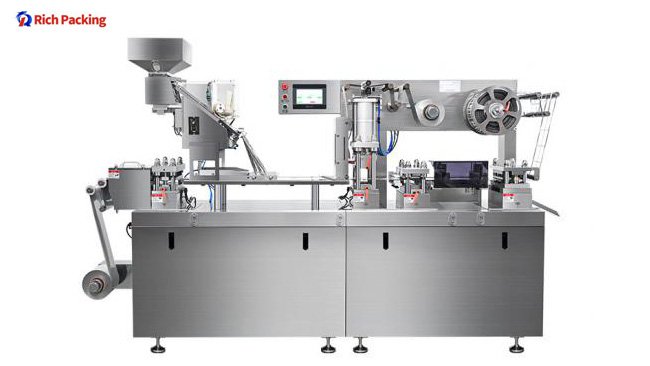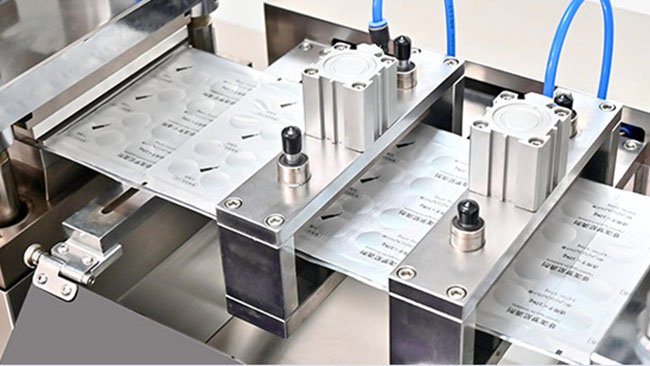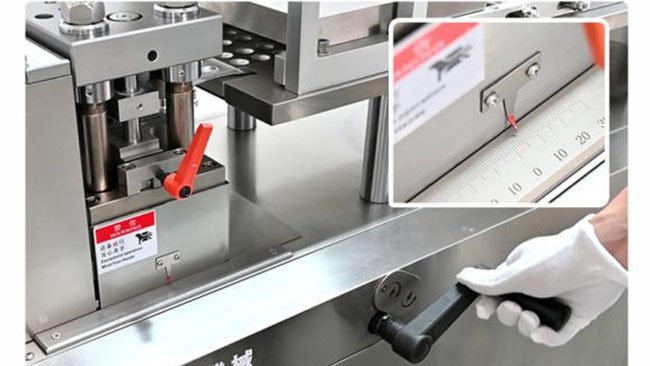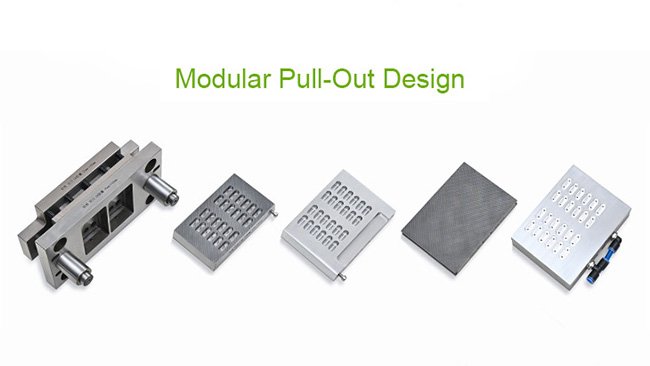Blister packaging machines, core equipment in the modern pharmaceutical, food, and electronic component packaging industries, directly impact production efficiency and product quality through their performance. With intensifying market competition and rising consumer demands for packaging, buyers are demanding more than just basic functionality from blister machines; they demand multiple features, including high precision, intelligent operation, and exceptional stability. This article will focus on three key features: full servo drive, four-station mandrel positioning, and modular mold design. It will also analyze how these technologies can bring practical benefits to buyers, reducing costs while improving overall production efficiency.

Full servo drive technology is the core of high-precision control for blister packaging machines and a key embodiment of the modern Industry 4.0 concept in packaging equipment. Traditional blister machines mostly use mechanical or partial servo drives. These drive methods are prone to deviations in pull distance due to wear of transmission components, temperature fluctuations, or prolonged operation, which in turn affects the uniformity of blister formation and sealing quality. The full servo drive system, through digital intelligent control, achieves zero-error adjustment of the pulling distance, ensuring precise positioning of each blister cavity. This system employs multiple servo motors working in concert with high-precision encoders for real-time feedback, creating a closed-loop control system. This ensures exceptional stability, regardless of high-speed operation or long-term continuous production, completely eliminating the problem of increased scrap rates caused by accumulated errors.

For buyers, the benefits of full servo drive are multifaceted. First, it significantly reduces the difficulty of equipment adjustment and operational complexity. Operators no longer need to rely on complex mechanical adjustments or frequent calibration. Instead, they simply input relevant parameters through an intuitive touchscreen interface, and the system automatically performs precise positioning and optimized settings. This not only significantly reduces the potential for human error but also significantly shortens commissioning time when changing product specifications. In the pharmaceutical industry, for example, tablets and capsules can vary significantly in size and shape. The full servo drive system of tablet blister packing machine allows production lines to quickly switch modes within minutes, ensuring the equipment is quickly back in efficient operation, effectively meeting the flexible production needs of high-mix, small-batch production.
Second, the equipment's long-term operational stability allows buyers to confidently produce large orders without worrying about equipment failure or loss of accuracy. This is of crucial strategic significance for meeting fluctuating market demand and improving customer response speed. According to industry statistics, blister packaging machines using a full servo drive can increase overall production efficiency by 25%-30%, while strictly controlling product scrap rates to less than 1%. This is far superior to the 5%-10% scrap rate of traditional equipment. Furthermore, the ease of adjustment significantly reduces the need for highly skilled technicians. Ordinary production personnel can become proficient in operating the equipment after simple, systematic training, effectively optimizing human resource allocation and reducing labor costs. From a return on investment perspective, while the initial investment in a full servo drive system is relatively high, the comprehensive benefits it brings ensure a short-term payback. In short, full servo drive not only raises the technical bar for blister machines but also brings quantifiable and sustainable economic benefits to buyers.
The four stations of a blister packaging machine—forming, heat sealing, creasing, and punching—are critical to packaging quality. The coordination accuracy of these stations directly impacts the final product's pass rate. In traditional equipment, adjustments to these stations often rely on manual labor from experienced technicians, a tedious and error-prone process that often requires repeated machine trials and adjustments, resulting in significant time and material waste. However, the innovative design of mandrel positioning technology, combined with external handwheels for free adjustment, has revolutionized this situation. Mandrel positioning uses a high-precision core to secure each station, ensuring that parallelism and perpendicularity are consistently maintained within extremely high precision during movement. The user-friendly external handwheel allows operators to make precise adjustments without disassembling any components, significantly improving the convenience and accuracy of equipment adjustments.

This advanced design is crucial to the overall performance of the alu blister packing machine. In the forming process, mandrel positioning ensures consistent depth and shape of each blister cavity, effectively preventing leakage from pharmaceutical or food packaging due to molding deviations. In the heat-sealing process, precise alignment ensures a complete seal between the aluminum foil or plastic film and the blister, improving not only the product's appearance but also, more importantly, significantly extending its shelf life. In the creasing and punching processes, a precise positioning system ensures the uniform separation of each blister unit, completely eliminating quality defects such as burrs and tears. Mandrel positioning enables perfect coordination of the four stations, ensuring the smooth operation of the entire production line like a precise Swiss watch and minimizing unplanned downtime caused by misalignment.
For buyers, the benefits of the four-station mandrel positioning system include production flexibility and overall cost savings. The innovative design of the external handwheel makes station adjustment and alignment extremely simple and intuitive, allowing even non-professional operators to quickly master the adjustments. For example, when the production line needs to switch between blister molds of different sizes, the operator simply turns a handwheel to synchronize and precisely adjust each station, eliminating the need to stop the machine and wait for specialized maintenance personnel. This feature can increase equipment utilization by 15%-20%. Furthermore, the precise alignment system significantly reduces raw material waste. According to actual production data, the use of packaging materials such as aluminum foil and plastic substrate can be reduced by 5%-10%, directly reducing the company's raw material procurement costs. More importantly, this precise positioning design effectively extends the equipment's lifespan. The mandrel positioning system minimizes abnormal wear on moving parts, significantly extending the equipment's maintenance cycle. Over the long term, buyers not only enjoy higher production efficiency but also significantly reduce spare parts replacement and equipment maintenance costs, thereby maximizing their return on investment.
3. Modular Mold Design: Quick Changeover and Efficient Maintenance
As a core component of the blister packaging machine, the mold's design directly impacts the equipment's production flexibility and maintenance efficiency. Traditional blister machine molds typically adopt bolt-on or monolithic structures, requiring disassembly of numerous components for replacement—a time-consuming and labor-intensive process that severely disrupts production schedules. In contrast, the innovative modular design, paired with a pull-out card slot quick-connect installation method, transforms this workflow entirely. Standardized and serialized, these mold modules leverage precise card slot positioning and quick-connect interfaces to achieve true "plug-and-play" functionality, slashing the time required for full mold set replacement from over 30 minutes to just 5–10 minutes and drastically boosting the machine's production adaptability.

This advanced design enhances overall blister packaging machine efficiency in multiple key ways. Amid increasingly diverse market demands, buyers often need to switch molds frequently to produce blister products of varying shapes, sizes, or materials—such as transitioning from round tablet packaging to square food containers. The modular design simplifies these production changes, enabling the machine to respond swiftly to shifting market needs. Additionally, the precision-engineered pull-out card slot structure ensures consistent positioning accuracy with every installation, eliminating operational failures and product quality issues caused by improper setup. It also streamlines mold storage and management: buyers can maintain a library of standardized molds, accessing them on-demand to align with production schedules and optimize the entire system’s operational efficiency.
For buyers, the benefits of modular mold design are comprehensive and immediate. First, simplified mold replacement minimizes equipment downtime, increasing uptime and overall production capacity—particularly valuable in industries like pharmaceuticals, where frequent product line changes are common, allowing companies to efficiently handle small-batch, diverse orders on a single production line and enhance market competitiveness. Second, the quick-connect installation reduces reliance on specialized technicians: ordinary operators can complete mold changes independently with minimal training, lowering dependence on external technical support and cutting operating costs by 15%–20%. Moreover, the user-friendly design improves operational safety by minimizing tool usage and reducing the risk of accidental damage. From a long-term perspective, the modular design supports continuous equipment upgrades and functional expansion; buyers can add new mold modules as business needs evolve, without replacing the entire machine, thus protecting initial investments and enabling sustainable development.
Full servo drive, four-station mandrel positioning, and modular mold design—these three core technologies together form the cornerstone of the efficiency and precision of modern blister packaging machines. These innovative technologies not only fundamentally raise the machine's performance ceiling but also provide buyers with tangible production benefits and competitive advantages by significantly reducing operational adjustments, enhancing production flexibility, and streamlining routine maintenance. As the packaging industry increasingly pursues intelligence, flexibility, and sustainability, investing in blister packaging machines with these advanced features means buyers can continuously optimize production costs while significantly improving product quality and market responsiveness, ultimately standing out in the fierce competition.
For forward-thinking buyers, choosing a blister machine with these features is more than just a simple upgrade of production equipment; it represents a strategic optimization of the entire production system, management processes, and business model. These advanced technologies enable blister packaging production lines to better adapt to modern production trends of small batches and high varieties, meeting consumers' growing demand for personalized and functional packaging, while also laying a solid foundation for enterprises' digital transformation and intelligent upgrades. In the future, with the in-depth application of Industrial Internet of Things (IIoT) technologies, these advanced blister machines will further evolve into core nodes of smart factories, creating continuously growing value for buyers.